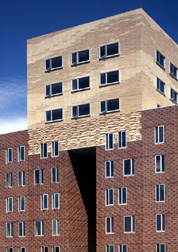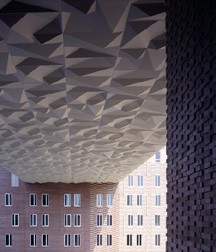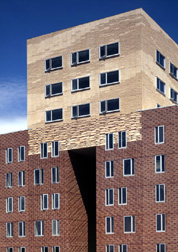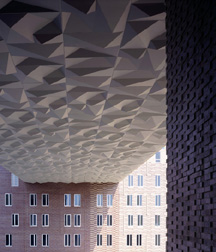One Western Avenue
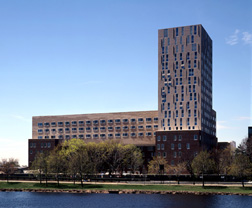
Harvard Graduate Student Housing
One Western Avenue is a significant project because it represents Harvard’s first step as it expands its campus in Allston. The building occupies a prominent site at the southeast corner of the Harvard Business School campus, adjacent to the Charles River, where Western Avenue crosses Soldiers Field Road. As such, the site marks the arrival to Harvard’s campus from downtown Boston and areas south.
The building’s configuration and image are based on our interpretations of its physical context: the nineteenth-century, five-story, brick-clad, U-shaped neo-Georgian courtyard houses and the mid-twentieth-century, twenty-story, concrete paneled modern towers. Both types are characteristic of the university’s riverfront and both have been excellently designed by the best architects of their times, most notably in the twentieth century, José Luis Sert.
Urbanistically, the five-story low-rise we placed along Western Avenue establishes a scale for future buildings to be built further inland, while the fifteen-story mid-rise on the riverfront forms—in a pairing with the taller buildings across the river—a virtual “gate” to Harvard when arriving from the river. In addition, to use in Allston the same building types that have been used in Cambridge speaks of the desire to make both sides of the river—and all thereby implied—equal.
While One Western Avenue combines the two emblematic types of courtyard and mid-rise, it adds something else to them: a three-story, bridge-like building raised four levels above the ground and spanning 180 feet.
This bridge is very important and performs several tasks:
First, it clearly divides the building’s main central void into two very different spaces, a courtyard and a front lawn; from the courtyard looking out, the river view appears framed, as if it were seen through a gigantic window, a condition that improves the experience of seeing the water.
Second, it makes a covered terrace between courtyard and lawn, a wonderfully tall campus “room” (to which the main entrance from Western Avenue directly leads), suitably “furnished” with a wooden platform intended for everyday as well as special occasions, and for individual as well group activities; a space like no other on campus indeed.
Third, from a pragmatic point of view, it allows us to produce two desirable conditions that normally exclude one another: a courtyard open to the river, as it should be, AND on top of its edge, three stories of apartments occupying the same “front-row” situation.
Fourth, from a formal point of view, the newness of the bridge squarely places the building in the domain of the twenty-first century, thus doing what Harvard has always done when it has built good buildings—as in the buildings of Bulfinch, Richardson, Gropius or Sert, all of which represent the best ideas of their times.
Consistent with our choice of building types is the choice of skin materials we have made: brick for the courtyard and cast stone for the mid-rise. But in order to produce visual variety, scale down the building masses and, indirectly, relate to the material articulation shown by both neo-Georgian and modern buildings present in the context, we have established a series of regulations that allows us to produce experiential richness without resorting to easy “Picturesquism” or casual decoration.
The courtyard building is wrapped in two brick patterns, one for the exterior walls and the other for the interior walls. These overlap in the entry passageway, thus producing a third pattern. The mid-rise and the bridge are clad in the same material, but used differently from one another, as are the types of windows they display (the novelty of the bridge finds its equivalent in the monolithic treatment of its volume.
More importantly, we have dealt with the notion of virtual “transparency” (one which is of great importance to both classical and modern architecture) as a way of producing a lucid, architectonic surface treatment. This has been accomplished by letting the ideal prismatic geometry of the various building masses register in the façade planes: when two prisms intersect, their patterns overlap, thus producing a new condition that recovers the prism’s ideal edge. Designing along these lines has allowed us to produce a building that is, we believe, very much a Harvard building, and one of its time and place.
1999-2003
